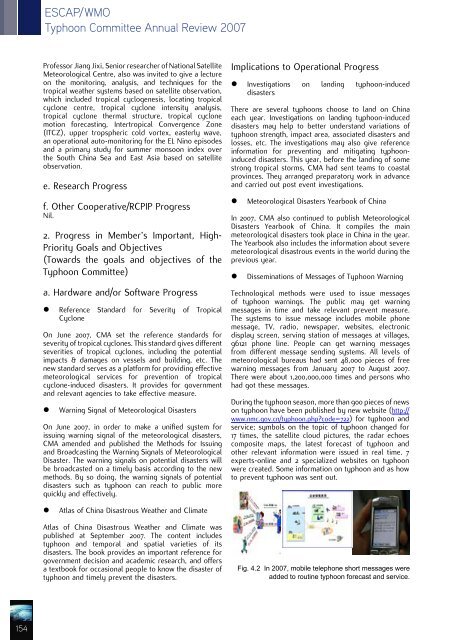200 - Typhoon Committee
200 - Typhoon Committee
200 - Typhoon Committee
Create successful ePaper yourself
Turn your PDF publications into a flip-book with our unique Google optimized e-Paper software.
ESCAP/WMO<br />
<strong>Typhoon</strong> <strong>Committee</strong> Annual Review <strong>200</strong>7<br />
Professor Jiang Jixi, Senior researcher of National Satellite<br />
Meteorological Centre, also was invited to give a lecture<br />
on the monitoring, analysis, and techniques for the<br />
tropical weather systems based on satellite observation,<br />
which included tropical cyclogenesis, locating tropical<br />
cyclone centre, tropical cyclone intensity analysis,<br />
tropical cyclone thermal structure, tropical cyclone<br />
motion forecasting, Intertropical Convergence Zone<br />
(ITCZ), upper tropspheric cold vortex, easterly wave,<br />
an operational auto-monitoring for the EL Nino episodes<br />
and a primary study for summer monsoon index over<br />
the South China Sea and East Asia based on satellite<br />
observation.<br />
e. Research Progress<br />
f. Other Cooperative/RCPIP Progress<br />
Nil.<br />
2. Progress in Member’s Important, High-<br />
Priority Goals and Objectives<br />
(Towards the goals and objectives of the<br />
<strong>Typhoon</strong> <strong>Committee</strong>)<br />
a. Hardware and/or Software Progress<br />
• Reference Standard for Severity of Tropical<br />
Cyclone<br />
On June <strong>200</strong>7, CMA set the reference standards for<br />
severity of tropical cyclones. This standard gives different<br />
severities of tropical cyclones, including the potential<br />
impacts & damages on vessels and building, etc. The<br />
new standard serves as a platform for providing effective<br />
meteorological services for prevention of tropical<br />
cyclone-induced disasters. It provides for government<br />
and relevant agencies to take effective measure.<br />
• Warning Signal of Meteorological Disasters<br />
On June <strong>200</strong>7, in order to make a unified system for<br />
issuing warning signal of the meteorological disasters,<br />
CMA amended and published the Methods for Issuing<br />
and Broadcasting the Warning Signals of Meteorological<br />
Disaster. The warning signals on potential disasters will<br />
be broadcasted on a timely basis according to the new<br />
methods. By so doing, the warning signals of potential<br />
disasters such as typhoon can reach to public more<br />
quickly and effectively.<br />
• Atlas of China Disastrous Weather and Climate<br />
Implications to Operational Progress<br />
• Investigations on landing typhoon-induced<br />
disasters<br />
There are several typhoons choose to land on China<br />
each year. Investigations on landing typhoon-induced<br />
disasters may help to better understand variations of<br />
typhoon strength, impact area, associated disasters and<br />
losses, etc. The investigations may also give reference<br />
information for preventing and mitigating typhooninduced<br />
disasters. This year, before the landing of some<br />
strong tropical storms, CMA had sent teams to coastal<br />
provinces. They arranged preparatory work in advance<br />
and carried out post event investigations.<br />
• Meteorological Disasters Yearbook of China<br />
In <strong>200</strong>7, CMA also continued to publish Meteorological<br />
Disasters Yearbook of China. It compiles the main<br />
meteorological disasters took place in China in the year.<br />
The Yearbook also includes the information about severe<br />
meteorological disastrous events in the world during the<br />
previous year.<br />
• Disseminations of Messages of <strong>Typhoon</strong> Warning<br />
Technological methods were used to issue messages<br />
of typhoon warnings. The public may get warning<br />
messages in time and take relevant prevent measure.<br />
The systems to issue message includes mobile phone<br />
message, TV, radio, newspaper, websites, electronic<br />
display screen, serving station of messages at villages,<br />
96121 phone line. People can get warning messages<br />
from different message sending systems. All levels of<br />
meteorological bureaus had sent 48,000 pieces of free<br />
warning messages from January <strong>200</strong>7 to August <strong>200</strong>7.<br />
There were about 1,<strong>200</strong>,000,000 times and persons who<br />
had got these messages.<br />
During the typhoon season, more than 900 pieces of news<br />
on typhoon have been published by new website (http://<br />
www.nmc.gov.cn/typhoon.phpcode=722) for typhoon and<br />
service; symbols on the topic of typhoon changed for<br />
17 times, the satellite cloud pictures, the radar echoes<br />
composite maps, the latest forecast of typhoon and<br />
other relevant information were issued in real time. 7<br />
experts-online and 2 specialized websites on typhoon<br />
were created. Some information on typhoon and as how<br />
to prevent typhoon was sent out.<br />
Atlas of China Disastrous Weather and Climate was<br />
published at September <strong>200</strong>7. The content includes<br />
typhoon and temporal and spatial varieties of its<br />
disasters. The book provides an important reference for<br />
government decision and academic research, and offers<br />
a textbook for occasional people to know the disaster of<br />
typhoon and timely prevent the disasters.<br />
Fig. 4.2 In <strong>200</strong>7, mobile telephone short messages were<br />
added to routine typhoon forecast and service.<br />
154
















